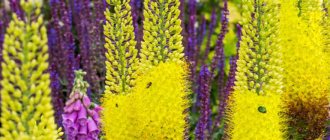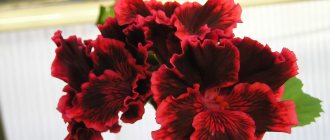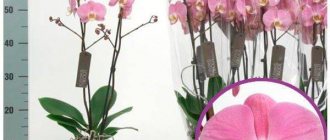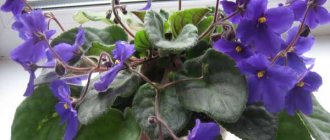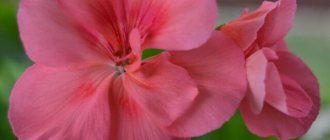Eremurus or Shiryash is a perennial plant that belongs to the Asphodelaceae subfamily of the Xanthorrhoeaceae family. The genus contains about 60 species. Translated from Latin, the name of the perennial means “Desert Tail”.
“Shirish, shiryash or shrysh” were assigned for the ability of the roots of some eremurus to produce gum arabic glue. The plant was first described in 1773 by the Russian explorer and traveler P. Pallas. The first hybrids were bred at the beginning of the twentieth century and work is still underway to propagate varieties of this plant.
Description and features of Eremurus
The rhizome is branched, similar to a spider or sea anemone, and has a large diameter. Numerous leaves are linear, triangular, the names of the species are distinguished by their habit.
Eremurus is an excellent honey plant that attracts insects with its loose inflorescence of orange or red shades already in early June. Most often, flowers of varietal forms and hybrids are found on sale.
Photo of a flower
Here you can see a photo of Cleopatra begonia, which is easy to grow at home.
Types and varieties of Eremurus
| Type / Variety | Height/Description | Flowers |
| Altaic | 1.5 m. Flower stems are directed at an acute angle. | Green-yellow. |
| Alberta | Loose peduncle 60 cm high. | Gray. |
| Bunge or narrow-leaved | 2 m. The leaves are narrow, bluish in color, the inflorescence is composed of small flowers, 60 cm. | Golden. |
| Bukhara | Peduncle 1.3 m, pear-shaped seed capsule. | White or pale pink. |
| Himalayan | 2 m. Inflorescence 80 cm. | White, covered with green stripes. |
| Wonderful | 1.5 m. Narrow leaves with three edges. | Yellowish. |
| Kaufman | Leaves with white pubescence, inflorescence 70 cm, diameter 7 cm. | White with a creamy tint and a bright yellow center. |
| Korzhinsky | Peduncle 50 cm. | Yellow-red. |
| Short-stamened | Inflorescence 60 cm. | Pale pink thickened, short. |
| Crimean | 1.5 m. | White. |
| Milky-flowered | 1.5 m. Long flowering without petal fall, leaves with a slight bluish bloom. | Whitish. |
| Powerful or robustus | 2 m. Peduncle 1.2 m. | Light pink or white. |
| Olga | 1.5 m. Leaves are bluish in color, inflorescence 50 cm. | Pinkish or white. |
| Tubergen | Dense peduncle. | Gray-yellow. |
| Achison | 1.7 m. Earliest flowering among the species. | White and pink. |
Thanks to numerous breeding works, hybrid species of Eremurus of various colors have been bred. Ruiter hybrids are mainly sold on the Russian market.
| View | Flowers |
| Cleopatra or Cleopatra's needle | Pink. |
| Money maker | Yellow. |
| Obelisk | Snow white |
| Odessa | Yellow with a greenish tint. |
| Romance | Pinkish pastel. |
| Sahara | Coral pink with dark purple veins. |
Eremurus (liatris) is white, but it belongs to the Asteraceae family.
Characteristics of culture
Eremurus is an unusual plant, its homeland is Central and Western Asia. Developed as a crop in the 19th century, it is now popular in European countries, the Russian Crimea, the Caucasus, Kazakhstan, and Western Siberia.
Known under other names: “shiryash”, “shrysh”, “Tsar’s crutch”, “Cleopatra’s needle”, “sparkler”.
It is a perennial of the Xanthorrhoeaceae genus of the Liliaceae family. Experts count more than 50 varieties. The name translates as “desert tail,” most likely due to the peculiar shape of the inflorescences. "Bengal fire" reaches a height of 130-140 cm, has a strong, durable, straight stem.
The leaves at the base form a basal rosette, and their shape varies depending on the variety and can have an elongated, cone-shaped, cylindrical shape. The root system consists of a main rhizome and numerous branches; the rhizome looks like a starfish.
Flowers in the form of bells are arranged in a spiral on a long peduncle, from 100 to 150 cm high, and come in different colors: yellow, orange, brown, white, pink, brown. The seeds, after a short flowering, ripen in fleshy spherical capsules.
Eremurus: planting and care
Eremurus is easy to care for and reproduces well with proper attention.
Planting Eremurus in open ground
Flowers are planted in a permanent flowerbed in late September-early October. Choose bright places with good drainage, which can be broken brick, expanded clay, pebbles and similar materials.
The place is prepared in advance. A drainage layer 5 cm high is sprinkled with a small layer of soil consisting of compost and turf soil. With the roots spread out, the seedlings are placed on it and covered with soil. The planting depth of the rhizome is 5-7 cm, the planting hole is 25-30 cm, between plants is 30 cm. Everything is well watered.
An important condition for rapid flowering is limited fertilization of seedlings. With abundant nutrition, they increase the green mass to the detriment of the formation of flower buds.
When planting purchased rhizomes, a distance of 40-50 cm is left between the divisions for large ones, 25-30 cm for small ones, the row spacing is set to about 70 cm. After this, the soil is well soaked.
Diseases
Cleopatra is susceptible to a disease characteristic of many begonias, such as fungal infection . It manifests itself as spots of rot on the leaves. If the plant is sick, the infected areas are removed, and the remaining part of the plant is treated with a fungicidal preparation. In the future, to prevent fungal infection, it is necessary to adhere to the correct temperature regime.
Other growing problems:
- Yellowing of leaves due to excess watering or too dry air;
- Brown spots caused by lack of nutrients;
- Poor growth and lack of flowering in the absence of fertilizing with potassium and phosphorus.
Proper care will relieve begonia from the above diseases.
Caring for Eremurus in the garden
The plant is unpretentious to grow. In early spring, the flowers are freed from shelter, then complex fertilizer (40-60 g) and 5-7 kg of rotted manure or compost per square meter are used as fertilizing. Before flowering, which occurs in June, the plant is well watered.
If the soils are poor, in May they are additionally fed with nitrogen fertilizer (20 g per sq.m.). Once flowering is complete, there is no need for moisture. If the summer is rainy and the ground is wet, watering is excluded. During the season, the soil is regularly loosened and weeded.
At the end of flowering, the bushes are dug up and left in a well-ventilated area for at least 20 days to protect them from rotting in moist soil. If it is not possible to dig, then a protection like an umbrella is placed over the flowers to prevent moisture from entering.
In autumn, a phosphorus fertilizer mixture is applied to the plantings in an amount of 25 g per square meter.
Dried roots should not be left until spring. They must be planted in the soil in the fall. The winter hardiness of the plant is very good, but before frosts, Eremurus are covered with fallen dry leaves and peat for better preservation. In the absence of snow, it is good to cover with spruce branches.
Obtaining new seedlings
To get a new plant from the mother sprout, you need to collect the seeds. Cuttings in this case are ineffective. Seeds placed in the ground in the fall germinate in the spring. Some - in a year. They need warmth and moisture. Shrysh blooms for the first time 3–5 years after planting.
Shrysh is a rather unpretentious plant, however, in order to maintain its healthy appearance, it is necessary to follow a certain number of rules, observing which, the flower will thank you with its lush flowering.
The original article is posted here: https://welady.ru/eremurus-shrysh-osobennosti-pravila-posadki-uhod
Reproduction of Eremurus
Flower division is carried out when new ones grow next to the planted rosette and they are well separated. If this is difficult, reproduction is postponed until the next season.
The place where the rosette divides is cut so that it and the main one each have several roots. Then the sections are sprinkled with ash to prevent rotting. The whole family is transplanted into the ground as a bush until next year.
When each division grows roots and buds form, the bush can be divided into separate ones. Such division of plants is possible once every 5-6 years.
Propagation from seeds
Sowing seeds directly into the ground is not a very good option. It is more reliable to grow by sowing in seedlings and then replanting.
At the end of September and beginning of October, pots about 12 cm high are filled with loose soil. Each seed is laid out to a depth of 1 cm, then kept at a temperature of +14...+16 °C. Germination can take 2-3 years. The top layer of soil should always be slightly damp.
In the first years, seedlings are not planted in open ground; they are left in the same pots to grow and strengthen. They are kept in a well-lit place, and when the leaves dry out, they are removed into the shade.
Water the seedlings so that the soil is always slightly moist. When it gets cold, pots with seedlings are wrapped with sawdust, spruce branches, dry leaves, and more recently with covering material. When the bush gets stronger and becomes large enough, it is transplanted into the soil. Plants grown from seeds bloom only after 4-7 years.
Shiryash: growing conditions in a summer cottage
Shiryash is a crop that is not picky about care, but there are still certain requirements for soil and light for their growth:
- Since this is a light-loving crop, for planting it you should choose sunny, shade-free areas of the garden or cottage.
- The stems of the tall plant are strong and strong; they are not afraid of even strong gusts of wind.
- The plant does not need special watering, but stagnation of moisture in the soil and groundwater are destructive for it.
- The soil for planting shirash is suitable for any acidity. The ideal soil composition is peat and loam. The main requirement for the soil is good water permeability and drainage so that moisture does not stagnate around the rhizome, which can lead to fungal diseases.
Diseases
Flowers are susceptible to attack by pests and diseases.
| Pest | Control measures |
| Slugs | Sprinkle the soil with tobacco dust, ash or ground chicken shells. |
| Rodents | Lay out the bait and fill the holes with water. |
| Aphid | Wash the flowers with soapy water. Insecticides (mixed with water):
|
The plant may be susceptible to diseases.
| Symptoms | Cause and disease | Corrective measures |
| Brown and dark spots on the leaves, weakness of the plant. | Dampness. | Fungicide treatment once every 2 weeks (with water):
|
| Fungal infection. | ||
| Rust. | ||
| Mosaic of leaves. | Virus infection. | There is no treatment. Digging up and destroying the plant. |
Shiryasha Pest Control
Some varieties of shirash are edible and are eaten. The succulent roots are a treat for mice, voles and moles. By gnawing through the rhizome, they create a breeding ground for slugs and woodlice, which cause irreparable harm to the plant. To protect plantings from rodent infestations, use repellers or traps. Roots damaged by rodents must be carefully dug up and sprinkled with ash to avoid rotting.
The above-ground part of the plant is most often attacked by aphids and thrips. Insecticides are used to destroy them. Shiryash also affects viruses, which are caused by improper care of the plant. To avoid complete infection of the plantings, the diseased plant must be destroyed.
Agricultural technology
Planting and caring for shirash is a mystery for many gardeners, due to the not very wide distribution of this type of plant and unusual agricultural technology.
Reproduction
Eremurus are propagated vegetatively and by seeds. The vegetative method is simpler, and the varietal characteristics of the parent plant are better preserved. They do this in two ways.
Here's what you need to do for the first method of reproduction.
- After the end of flowering of the eremurus in August-September, the rhizome is dug up.
- Young Cornedonians are separated from it and sent to dry in a cool, dry room or under a canopy.
- At the end of September, at the same time as the planting of garlic and tulips, Cornedons are planted in the garden.
The second method of vegetative propagation allows you to leave the plant in its place. The sequence of actions is as follows:
- In autumn, in dry weather, the rhizome is carefully dug up.
- Without removing it from the soil, cut it into four parts with a sharp knife.
- Places of cuts are sprinkled with crushed coal or ash, protecting them from rotting.
- Cover with dry soil.
- The following fall, the root is dug up and the established Cornedonians are separated.
Seed propagation is a longer process. Eremurus from seeds bloom only in the fifth or sixth year.
Attention! By sowing the collected seeds, you do not guarantee the preservation of parental characteristics, but you can get a completely new original hybrid!
If you decide to collect your own seeds, then you need to prepare for this in advance. Even during flowering, the peduncle should be cut in half to ensure that the seeds, and the best of them are at the bottom of the flower plume, ripen well, then proceed as follows:
- After flowering, cut off the flower stalks and lay them out to dry and ripen.
- We separate the dried seeds from the husk.
- Before the onset of severe frosts, we sow them in the garden bed to a depth of 1.5-2.5 centimeters.
- Shoots will appear in the spring of next year.
Often, seeds from unharvested shirashi plants fall onto the soil and sprout in the spring. Such seedlings are also suitable for transplanting to a new location.
Landing
The main factor when planting shirash is choosing the right location for its placement. In this case, you should be guided by the following criteria:
- Illumination by the sun should be provided throughout the daylight hours;
- the soil must have a neutral or slightly acidic reaction;
- soils should be light and well drained;
- close occurrence of groundwater is not allowed;
- It is desirable to protect plants from cold winds.
Cornedonians plant Eremurus at a distance of thirty to sixty centimeters, depending on the varietal characteristics. Planting holes or trenches are pre-filled with drainage: pebbles and sand. The soil into which the planting “octopuses” are planted is placed on top of the prepared cushion. After planting, the soil is mulched. Since planting is carried out in the autumn, watering is not carried out.
Care
Desert tails in their natural environment do without watering, so in the garden they only need the moisture that they get from the atmosphere. Moreover, during long rainy periods, it is recommended to spread a film under the shirash to cut off excess moisture. In this regard, soil mulching is carried out with breathable materials: pebbles, straw, spruce branches.
Rhythms of development
The climatic conditions of the homeland of Eremurus are characterized by frequent and sharp changes in temperature and precipitation throughout the year, hot and dry summers, as well as wet and cool winters. Such conditions determine the rhythms of plant development, the need for heat, nutrition and water. In spring, when the soil warms up, the plant grows quickly. During this period, Eremurus likes more humidity than usual.
The fruits ripen in the hot part of summer. After this, the plant enters summer dormancy and the above-ground part dies. With precipitation in the fall and at a time when the temperature drops steadily, the flower can suddenly awaken to form a network of fine roots and an overwintering bud. Some species form a bud in the spring. Eremurus endures winter dormancy, even in severe frosts, in order to please the eye of its owner again in the spring.
